Buildings
ACROPOLIS
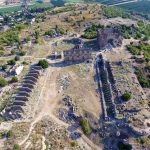 |
 |
AGORA
The agora, designed in a square plan, was built symmetrically in the centre of the hill (Acropolis) where the city was founded, in the mid-Hellenistic Period. The Agora of Aspendos was the heart of the city’s commercial, social, and political activities. Unlike the typical agora layouts seen in contemporary cities, which were enclosed by stoas and shops, it was surrounded by an additional market building and other public buildings apart from the stoa in front of the double-storeyed shops.
The buildings surrounding the agora were arranged as follows: The Double-Storeyed Shops/Stoa Complex to the west, the Hellenistic Market Building/Basilica/Church to the east, the Monumental Fountain (Nymphaeum) to the north; and the Bouleuterion/Odeion (?) to the north of the Nymphaeum. The market building stands as the representative building of the Hellenistic Period in the agora.
The other buildings surrounding the agora were built in different phases of the Roman Imperial Period by expanding the settlement terrace.
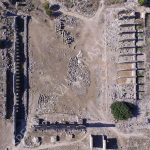 |
 |
DOUBLE-STOREYED SHOPS / STOA COMPLEX
Extending along the western edge of the agora, the Double-Storeyed Shops/Stoa Complex measuring 16.50 x 72.50 m is a monumental building complex comparable in monumentality to the Roman Basilica. It was probably added to the west of the Agora during the construction of the Roman Basilica on the east, to meet commercial and public needs. This building complex, formed by 15 adjacent shops, has a mosaic-paved portico in the front, while storage units are found at the rear. However, no traces of the architectural blocks belonging to the portico have survived to the present day.
Even the bare walls of this impressive building complex reveal the splendour of the city. Although not conclusively established, the excavations carried out in the shops imply that the complex was built in the early Roman Imperial Period. The last phase of use is thought to be the second half of the 3rd century AD.
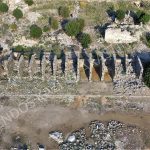 |
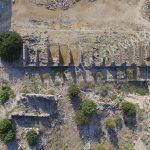 |
HELLENISTIC MARKET BUILDING / BASILICA / CHURCH
The Roman Basilica measuring 105×27 m borders the eastern edge of the agora. Having been partially built on top of the multi-storeyed Hellenistic Market Building and expanded to the east, it was built with three naves on massive vaults on a north-south axis. In the northern part of the building there is a monumental vestibulum (entrance hall), whose walls have largely been preserved. Considering both the similar examples and the architectural decorative elements, the basilica, which finds its counterparts only in a few cities of Asia Minor, is believed to have been built in the 1st century AD. Undoubtedly, this gigantic building let Aspendos shine among other cities competing to become a Roman city. During the Christian era, Aspendians converted the monumental Roman Basilica into a church to create a worship space for the new religion. An apse was built at the southern end of the building, on the axis of the central nave, while the vestibulum to the north changed in function and probably served as a living space for the clergy. The archaeological evidence suggests that following its conversion into a church, the basilica remained in use until the end of the 12th century AD.
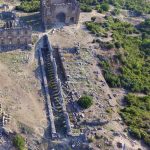 |
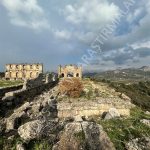 |
MONUMENTAL FOUNTAIN (NYMPHAEUM)
The two-storeyed nymphaeum, preserved nearly intact, formed the northern border of the agora. It has five niches in each of the upper and lower storeys with the central niches being larger than the others. The façade of the building was adorned with decorated blocks and was probably enlivened by statues placed in the niches. The water was brought to the nymphaeum through a canal running from the aqueducts. The present appearance of the decorated blocks, dated between 160-180 AD, is inferred to be related to an arrangement made at a later time.
 |
 |
BOULEUTERION / ODEION?
The Bouleuterion (Council House) located north of the Nymphaeum and to the west of the Basilica, was presumably converted into an Odeion in the 3rd century AD. The entrance of the semicircular building lying on an east-west axis is on the west side. The apsidal section of the façade is supported by sloping buttresses. A rectangular courtyard and an altar are found in front of the building. The honorary inscriptions at the entrance are remarkable. The absence of the seating tiers in the building, dated to the 2nd-3rd century AD, suggests that they were made of wood.
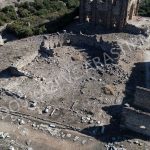 |
 |
THEATRE
Without a doubt, the most striking building that adds to Aspendos’ fame is the Theatre which stands as the best-preserved ancient theatre of the Mediterranean world, surviving almost entirely intact to our day. Built between 160-180 AD by an architect named Zenon, son of Theodorus, the construction of the theatre was sponsored by two benefactor brothers named Aulus Curtius Crispinus Arruntianus and Aulus Curtius Auspicatus Titinnianus, as per the will of Aulus Curtius Crispinus. The semicircular theatre with two caveas, partially built against the slope, has a seating capacity of approximately 7000-8000 spectators. The cavea consists of 20 seating tiers in the lower part and 21 in the upper part, with a vaulted gallery formed of columns and arches located above. The entrance to the theatre is provided by vaulted galleries (parodoi) on both sides. The well-preserved two-storeyed stage building was adorned with columns, niches, and statues, as well as very rich architectural decorations. Five doorways on the stage platform provide access for the performers. The stone-paved orchestra is semicircular following the Roman style. The theatre owes its remarkable state of preservation not only to its use as a palace, with certain additions, during the Seljuk period, but also to its compact design encompassing the stage building and the cavea.
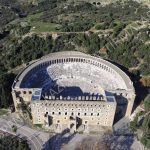 |
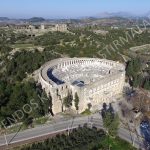 |
TEMPLE
The temple is located north of the East Gate, on a levelled rocky terrace overlooking the plain on the Acropolis and is oriented north to south. The only remains of the temple are the podium and the partially preserved temenos walls. An inscription from the Hellenistic Period mentions the existence of the Temple of Artemis in Aspendos. However, the scarce evidence regarding the temple prevents scholars from associating it with the Artemis cult referred to in the inscription. Nevertheless, the location of the temple indicates that it hosted a prominent deity worshipped in Aspendos.
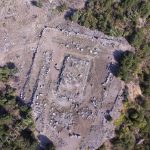 |
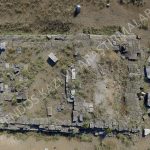 |
MONUMENTAL GATE
The Monumental Gate, built to the north of the Bouleuterion and near the city centre, is positioned on a stone-paved road with a canal system connecting to the Agora. A profiled block from an uninscribed statue base found near the monumental gate, which has a single, large arch indicates that the gate was surrounded by statues. The ashlar masonry of the gate formed by sandstone blocks shows traces of repair and reinforcement from Late Antiquity (5th-7th century AD). Both the traces of repair and reinforcement and the presence of Late Antique structures around the gate indicate that it maintained its function during this period.
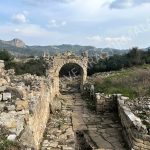 |
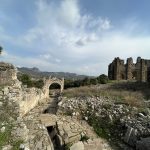 |
AQUEDUCTS
An engineering marvel, the Aqueducts of Aspendos are one of the monumental structures built in the 2nd century AD, during the Roman Imperial Period, to meet the city’s water needs.
The water was brought from two springs in Pınarbaşı, located in Gökçepınar Neighbourhood, about 15 km as the crow flies from Aspendos, through canals, bridges, and tunnels. The arches near the city centre, which can be followed uninterruptedly for 2 km, are among the rare examples in the Mediterranean world that have survived to our day. The two siphons of the aqueducts reaching a height of approximately 30 m, and the almost intact bridge of arches are quite fascinating. A repurposed inscription records that Tiberius Claudius Italicus financed the construction of the aqueduct through a donation of around 2 million denarii. Epigraphic research is ongoing regarding this information which has yet to be proven. Traces of different uses from later periods were also identified on the structure.
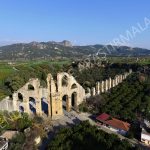 |
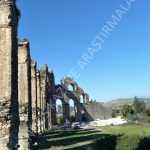 |
 |
STADION
The Aspendos Stadion is located on the plain east of the acropolis in the north-south direction. The U-shaped stadium terminating in a sphendone is estimated to have a capacity of approximately 8000 people. The building, which was used for competitions, measures 215 m long and 28.50 m wide. Most of the seating tiers of the stadium are buried beneath the soil. However, the examples on the surface suggest they were made of limestone. The seatings on the east and west rise on vaults. Some of the vaults supporting the relatively better-preserved eastern seating are thought to have served as shops. Like most of the surviving public buildings in Aspendos, the stadium is dated around the 2nd century AD, but an earlier construction date seems highly possible.
 |
ROMAN/SELJUK BRIDGE
The bridge on the Köprüçay (Eurymedon) River, built at the same spot using the foundations of a former Roman bridge that was demolished, has seven arches. Recent research has revealed that it was built in 1239/40 by Ghiyath al-Din Kaykhusraw II (1237-1246), the son of the Anatolian Seljuk Sultan Ala al-Din Keyqubad I (1220-1237). Along with the remains of the Roman bridge, the structure measures approximately 260 m long and 4.50-5.70 m wide.
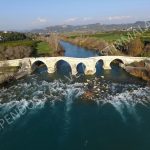 |
LATE ANTIQUE QUARTER
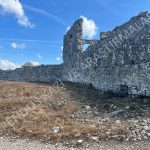 |
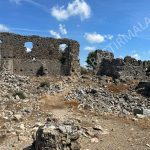 |
LATE ANTIQUE BUILDING
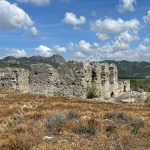 |
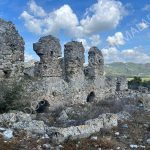 |
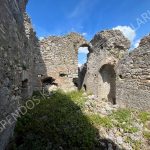 |